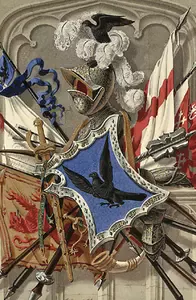- Home
- Neptune and Triton
neptune
[ + links to: Neptunian Allure - Olaf Stapleton - Outlaws of Neptune - The Sea Empress - Triton - What to see on Neptune ]
In twentieth-century fiction Neptune has fared somewhat better than Uranus. (For Neptune's major moon see the separate page on Triton.)
We have three fairly copious sources for our knowledge of Old Solar System Neptune. This page will mostly cover the first two; for the third source, see Neptunian Allure.
The first source is a brilliant, wonderful, high-minded and powerful account of a super-civilization of far-future humans. These "Neptunians" are descended from settlers who had to re-evolve over hundreds of millions of years to adapt to the conditions on that world. Such is the mind-boggling scenario we're given in Last And First Men and the first part of Last Men in London.
But it gives us no map.
On the other hand, for Captain Future's Neptune we do have an available map.
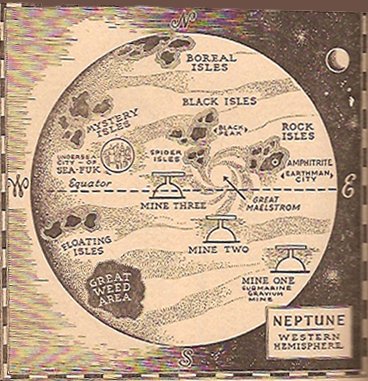
In this scenario there's no high-mindedness, no spiritual excitement except what comes from an adventurous romp suitable for a teenage reader. That's what we get in Captain Future's Challenge.
...Far out into the dusk stretched the vast vagueness of the planetary sea.
Curt's gray eyes kindled, and he breathed the salt, tangy air deeply. There was something about this wild ocean-world that called to Captain Future's unfettered spirit. The knowledge that the dim sea stretched for a hundred thousand miles around the giant world was somehow stimulating. Vast reaches of that mighty watery waste had never been sailed by men, though there were horrific legends about it...
Stid: You're a wee bit sly, Zendexor, the way you juxtapose Olaf Stapledon's Last Men with Captain Future. I've noticed this sort of ridiculous comparison is a kind of habit with you.
captain future weighed against the last men
Zendexor: It's incongruous, I admit. Still, such way-out matchings sometimes produce surprising results.
For instance this one shows me that there's a sense in which the Captain Future tales are more realistic than Olaf Stapledon! Can you guess in what way this is true?
Ah, you're thunderstruck! I'll have to tell you!
Right then, here's the point at which Stapledon falls short of Cap.F.: the gravity of Neptune.
Stapledon consistently over-estimates it. In reality, Neptune's greater mass is offset by its greater radius and lesser density, so that its pull is only marginally greater than that of Earth. Edmond Hamilton is therefore more right to describe the "tossing, endless blue waters" of Neptune (if we accept, for the sake of argument, the existence of a water ocean on that planet) than Stapledon is to assert that on Neptune
oceans are waveless. The stout sphere holds its watery cloak so tightly to it that even the most violent hurricanes fail to raise more than a ripple. [Last Men in London, p15.]
Stid: Well then, what are you going to do about this? It won't do, you know, to leave Cap. Future with a one-nill score against Olaf Stapledon.
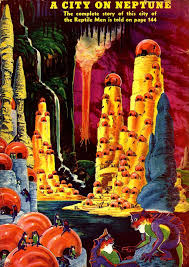
Zendexor: Don't worry, the competition isn't all that serious. In discussing Captain Future I'd prefer to narrow my focus and just consider the OSS worth of those swashbuckling tales in their own limited terms.
That's to say: how far do they go towards giving us any real depth to their planetary characters?
Here, for instance, in this particular case of the Neptune of Captain Future: how far might we say it goes, towards giving us a literary equivalent of Frank R Paul's "A City on Neptune"?
Well, try this:
The black submarine city ahead grew larger as Curt and his guards approached. Amazedly, Curt looked upon this weird metropolis at the bottom of the sea. It was built of black stone quarried from the sea-bottom. The buildings were cubical, with barred windows and roofs to keep out wandering beasts of prey. Many of the structures were of considerable size, and near the heart of the city was a massive pyramidal building that seemed the center of its strange life.
As Curt Newton was taken across the roofs of the black metropolis, he looked in wonder at the thronging population that swam in flocks and swarms above the roofs. Men, women and children - all were supple and finned of body, all wore metal-mesh tunics, and all seemed to have their own occupations or professions just as in any city of the land.
Curt glimpsed buildings that might have contained factories, metal-working shops where unquenchable atomic-flames were used for underwater foundry work, other structures that seemed scientific laboratories. He marvelled at the astounding webwork of an alien civilization beneath the waters!
"And nobody in the System ever guessed it," he thought, staggered. "Nobody but the Neptunians with their age-old legend of the sea-devils - " [Captain Future's Challenge, pp.110-1.]
Note the typically confusing use of the word "Neptunians" to mean the comparatively human land-dwellers, doubtless COMOLD-relations of Earthmen. The real Neptunians are the "sea-devils", surely. Or at least we can hope that they weren't also descended from the same interminable old human galactic stock - though elsewhere it says that the underwater folk
looked vaguely human. But the two legs of their white bodies seemed to have grown together into a powerful, tail-like limb that ended in fins instead of feet. And their short, powerful arms were finned at wrists and elbows.
Their heads were hairless, their faces quite human-featured. But at the base of their throats were open gills, pulsing rhythmically as they breathed the water.... [ibid., pp.93-4.]
So there you are. The jury is out - but I choose to consider them real Neptunians. And that brings me to the point where I have to say, we've just about covered as much as Captain Future can give us. It's all vivid but perfunctory. The story moves at breakneck speed and it covers a lot of territory but...
Stid: But it's superficial. Yet at least the culture of the OSS in Captain Future isn't defeatist or wimpish.
Zendexor: Whereas...?
Stid: Don't you think as I do, in your heart of hearts, that Stapledon's Last Men were wimps to accept their coming extinction by the radiation from the Mad Star?
Zendexor: I'm surprised at you, Stid. Astonished, in fact. First you support Stapledon against Hamilton and then you turn around and complain as though you preferred the adolescent romps of the Captain Future stories to a fantastically advanced adult's account of a far-future civilization. You're behaving out of character, Stid!
Stid: They exasperate me, those Last Men. Surely for a people of their calibre it ought to have been child's play to build a fleet of generation starships and head out from the Solar System to escape its destruction... they had a few thousand years left in which to prepare, after all! I guess I do prefer Captain Future.
Harlei: Don't you dare say the Last Men were wimps; they were a great people whose minds were immeasurably beyond ours...
the last men and their world
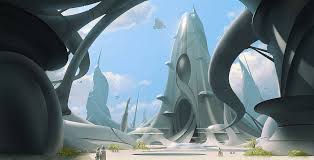
Zendexor: Let me deal with this. Harlei, you're right to defend the Last Men from the charge of wimpitude; it's a ridiculous charge to bring. On the other hand, Stid is getting at something. And it's a point which, I think, Stapledon foresaw. We'll thrash this out and then we'll go on to look at the Last Men's world, Neptune, itself.
Faced with final cosmic calamity two gigayears in our future, Stapledon's Last Men don't give up without a fight. But their struggle isn't directed towards trying to save themselves bodily by the construction of a fleet of starships (they seem to have had an agoraphobic fear of interstellar travel). Instead, they start a huge, selfless preservation-project of a different kind, namely, their attempt to "seed" the universe...
Stid: But while doing so they admit they need inspiration from us!
If there is to be any possibility of success, we must undertake a very lengthy programme of physical research, and finally organize a world-wide system of manufacture. The work will not be completed until our physical constitution is already being undermined, and the disintegration of our community has already begun. Now we could never fulfil this policy without a zealous conviction of its importance. Here it is that the past can help us. We, who have now learnt so thoroughly the supreme art of ecstatic fatalism, go humbly to the past to learn over again that other supreme achievement of the spirit, loyalty to the forces of life embattled against the forces of death. Wandering among the heroic and often forlorn ventures of the past, we are fired once more with primitive zeal. Thus, when we return to our own world, we are able, even while we preserve in our hearts the peace that passeth understanding, to struggle as though we cared only for victory.
Zendexor: So there you are - not wimps but heroes, though I dare say you, Stid, will point out that it's a pity they didn't put that "primitive zeal" to the use of achieving starflight. I agree their terror of the interstellar spaces is out of character - one of the minor inconsistencies in Stapledon.
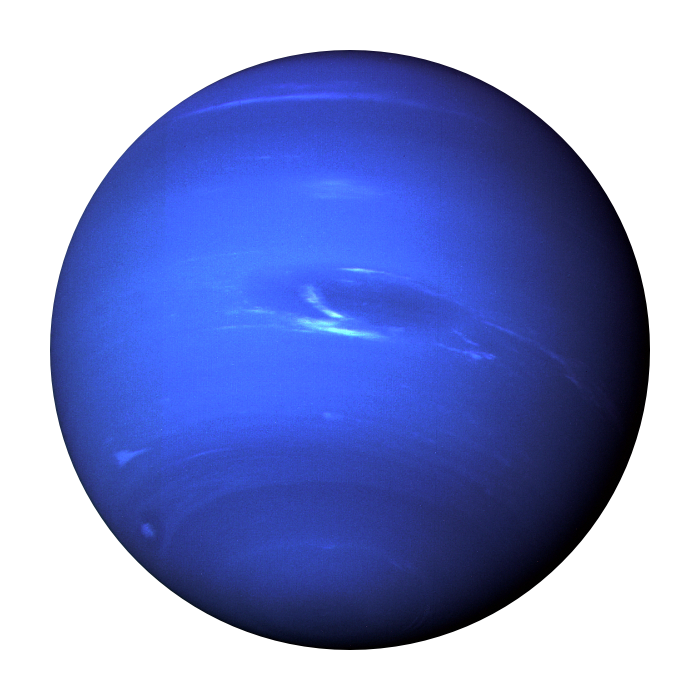
Another inconsistency, or at any rate an area of mystery, relates to the evolution of the Neptunian environment, but I discuss that point on the Stapledon author-page.
Suffice it to say here, that during the aeons following Man's forced migration from Venus to Neptune, the bloated Sun cools to a more moderate blaze, the planet's era of crustal shrinkage comes to an end, the atmosphere becomes less murky so that the skies clear to some extent -
Stid: Hey! How do you know that - about the sky clearing?
Zendexor: Elementary my dear Watson. I refer you to page 284-6, where the narrator explains the physiology of the Last Men.
If one of the First Men could enter the world of the Last Men, he would find many things familiar and much that would seem strangely distorted and perverse...
The pair of occipital eyes... would shock him; so would the upward-looking astronomical eye on the crown, which is peculiar to the Last Men. This organ was so cunningly designed that, when fully extended, about a hand-breadth from its bony case, it reveals the heavens in as much detail as your smaller astronomical telescopes...
Get it? Not much point in that if the sky hasn't cleared.
Stid: I see. So we've got to be detectives, to deduce things about the world of the Last Men from the implications in the text, rather than expect to be told straight.
Zendexor: Not all the time, but yes, it helps. For example, though the skies are clearer, they still contain some clouds, as we know from the landscape described:

Our visitor would notice... scattered about the green countryside, many buildings, mostly of one storey; for there is plenty of room on Neptune even for the million million of the Last Men. Here and there, however, we have great architectural pylons, cruciform or star-shaped in section, cloud-piercing, dignifying the invariable plains of Neptune. These mightiest of all buildings, which are constructed in adamantine materials formed of artificial atoms, would seem to our visitor geometrical mountains, far taller than any natural mountain could be, even on the smallest planet. In many cases the whole fabric is translucent or transparent, so that at night, with internal illumination, it appears as an edifice of light. Springing from a base twenty or more miles across, these star-seeking towers attain a height where even Neptune's atmosphere is somewhat attenuated. In their summits work the hosts of our astronomers, the essential eyes through which our community, on her little raft, peers across the ocean. Thither also all men and women repair at one time or another to contemplate this galaxy of ours...
Stid: You're not so clever after all, Zendexor. For it may well be (judging from the above passage) that it's only atop those pylons that the Neptunians can use their "astronomical eye". In which case you were wrong to assume, from their possession of such an eye, that the skies must be clear when seen from down on the planet's surface.
Harlei: Let me interrupt a moment. You're both forgetting that bit during the Neptunian picnic in Last Men in London when the narrator/controller and his lady watch the sky after sundown - from a point along a coastline, hence definitely at the surface of their world:
...the colours of the sunset gave place to the profound azure which the Neptunian sky assumes by night for Neptunian eyes. Stars began to appear, first singly and faintly, then in companies and brightly patterned constellations. The wide heaven flashed with them...
Zendexor: All right, that settles that. The atmosphere certainly must have cleared by then, by whatever means. Well done Harlei for being such an attentive reader. And now let's see what else we can say about the Neptune of the Eighteenth Men.
Harlei: It has lands and seas.
Zendexor: Right. And the lands are - some of them - continental in size. (Unlike Captain Future's Neptune where the most you get is islands - though some of them, on the map, look quite large.)
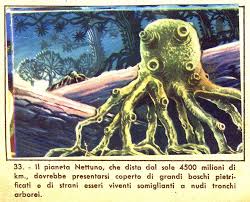
When our children attain physical adolescence, nearly a thousand years after birth, they leave the safe paths of childhood to spend another thousand years in one of the antarctic continents, known as the Land of the Young. Somewhat reminiscent of the Wild Continent of the Fifth Men, this territory is preserved as virgin bush and prairie. Sub-human grazers and carnivora abound. Volcanic eruption, hurricanes, and glacial seasons afford further attractions to the adventurous young...
Stid: Being myself merely one of the primitive First Men, and therefore more akin to the "adventurous young", I sometimes get a bit exhausted with the adult Last Men, with their intellectual and moral stature, their forays into group consciousness, their ninety-six sub-sexes -
Zendexor: I know, one isn't always in the mood - I myself would prefer to know comparatively less of the Eighteenth Men and more of their predecessors the Fourteenth, Fifteenth and Sixteenth. Nevertheless, for the sake of some good views over the Neptunian landscape, let's follow the controller-narrator of Last Men in London as he and his paramour fly to their rendezvous with the Racial Mind:
At dawn we rose. After a short swim, we put on our flying-suits, those overalls studded with minute sources of sub-atomic energy on the soles of the feet, the palms of the hands, and the whole front surface of the body. It is with these that all lesser flights are performed in our world; and as the action entails much skill and some muscular exertion, it is a delight in itself. Side by side we climbed the air, until the coast was like a map beneath us. We headed inland, first over a wide tract of rock and prairie, marsh and scrub, then over corn and orchard, sprinkled with innumerable homes. Once we passed near a great building, whose crystal precipices towered over us with snow on their cornices. A white cloud covered its upper parts, save for one slender pinnacle, which tiptoed into the sunlight. Sometimes a flying-boat would detach itself from the walls or emerge from the cloud. As we travelled over more densely inhabited regions, sprinkled somewhat more closely with private houses and cottages, a more numerous swarm of these flying-boats continually passed over our heads in all directions from horizon to horizon at so great a speed that they seemed darting insects. We encountered also many fliers like ourselves. Many we saw beneath us, moving from house to house across the intervening tillage. At one point an arm of the sea lay across our route; and there we saw, entering dock, a five-mile long ether-ship, lately returned from Jupiter or Uranus with a cargo of foodstuffs. She was a great fish of stainless metal, studded with windows over her back and flanks...
Harlei: Ether-ship. I like that phrase. Brings back a Wellsian period flavour, when space was properly big to us. These are the moments when the strenuous greatness of the Last Men stoops to caress our imaginations with an Old Solar System glow.
back to the primitive
Stid: Yeah, let's leave while the going is good - I mean before we get onto the Racial Mind, which is a bit much for little old me. I mean, let's abandon Stapledon for now and look for some rather more primitive literature to discuss!
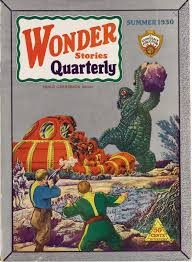
Zendexor: Or even just gaze at the colourful Neptunian monster in the illustration for the relevant title, The Monsters of Neptune.
Pity they don't reprint that one in anthologies - many fans looking at that picture must be dying to know what the Earthmen did after their ship was trampled. But fortunately, you can now find out - Wonder Stories Quarterly can be read online: and the tale is discussed, along with two others, on our page, Neptunian Allure, which thus deals with the third of the three sources of 20th-century literary Neptune.
Now, if you think that the above picture makes Neptunians out to be a bit too aggressive towards visitors, you can be reassured by the other Frank R Paul painting shown here.
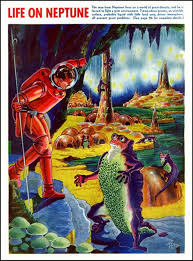
Harlei: Actually, to me the similarities between the two pictures are more important than the differences.
I mean to say: the raging monster, and the friendly-looking alien, both (to me) create a scene of beautiful nostalgia.
In fact I might even prefer in some ways to live in the first picture, as I could walk about on that Neptune without a space-suit. The two guys fighting the monster may be under a lot of stress but at least they can breathe the air. And what would that imply, on a world of that size? Maybe more than two thousand million square miles of terrain to explore, unencumbered by oxygen flasks and helmet! On the other hand the landscape in the second picture has a special beauty...
You know what, I think I'd sign up for either one of those expeditions.
Stid: But if you were actually there, in that first picture - if it came alive like the picture of the Narnian ship in The Voyage of the Dawn Treader, pulling you through the frame and into the situation for real - wouldn't you succumb to horror and dismay? Would you keep your sentiment of nostalgia? I think not!
Harlei: But after we'd dealt with or evaded the monster, the wonderment would come flooding back in: "hey, we're here, we're on Neptune!!!" And it would be the OSS Neptune.
Stid: Whatever that may entail. There's a recognizable "standard model Mars", but I'm not sure there is a "standard model Neptune". What do you say about that, Zendexor?
the neptunian overlaps
Zendexor: I suggest, look for correspondences. Overlaps, which help to accumulate the characters of worlds. Such as, in this case: Neptune the Mystic - as in composer Gustave Holst's The Planets - overlapping with the mystic side of Stapledon's Last Men, and, in turn, the mind-travellers of the Last Men overlapping with the mind-exchange techniques of the undersea Neptunians in Captain Future's Challenge... just for example. Anyhow, a linking thread does exist, or can be made to exist. The way our minds work, we create wrapped-up packages of ideas and impressions, including this one called "Neptune", which takes its own particular shape and character from the sum total of what has been written and painted and imagined...
I might also say, that a theme common to quite a few stories (though admittedly not of The Monsters of Neptune) is that of Neptunian superiority in cultural attainment and/or sheer power. Neptunians seem quite often to be formidable in some way or other. On the most highbrow level we have Stapledon's human Neptunian descendants. In the delightful 1960s children's-TV series Space Patrol we had the rather snooty telepathic Neptunians who thought themselves a cut above the denizens of the inner Solar System ("They still speak with their mouths!" one of them observed in mirth, emitting thoughts audibly).
See also the common theme of "defeatedness" in Neptunian Allure.
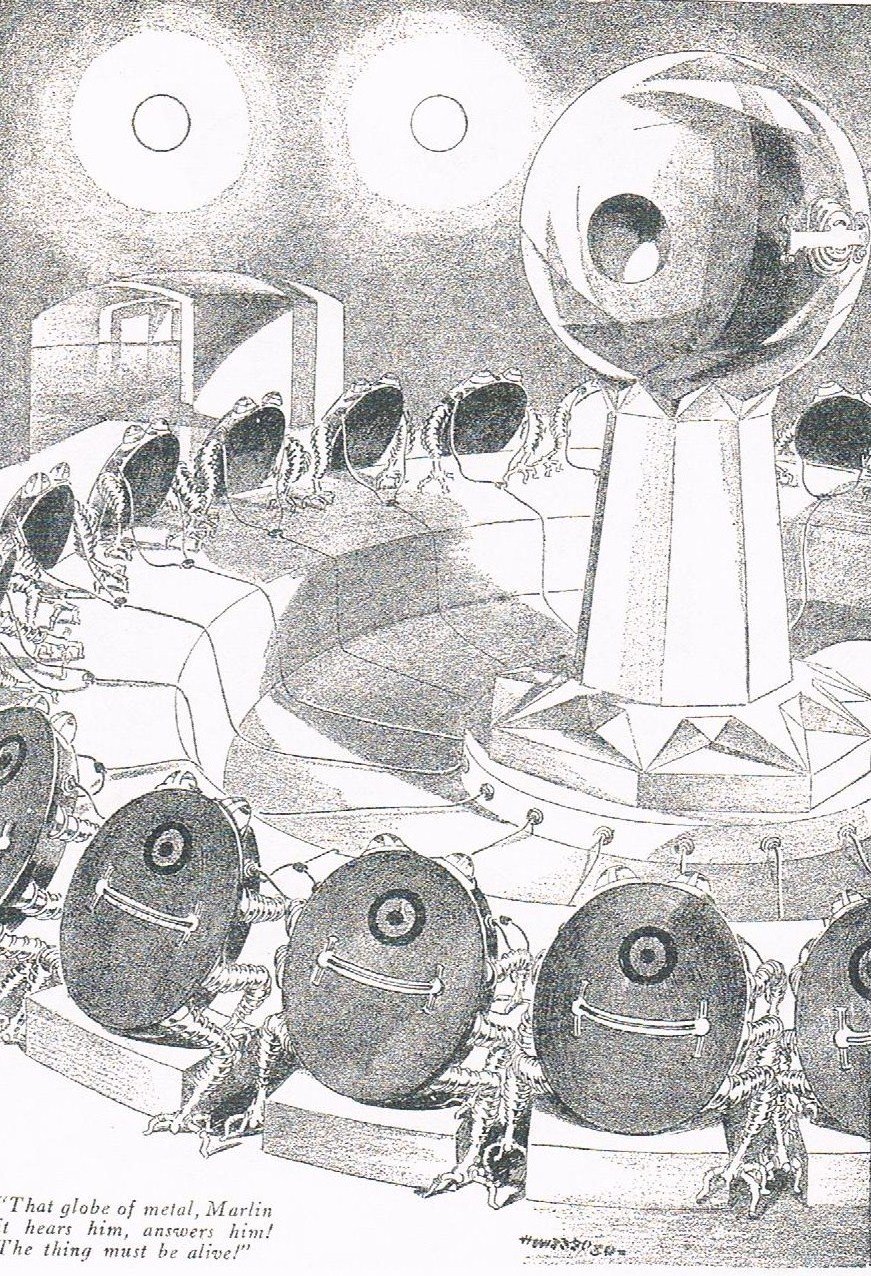 disk-bodied Neptunians
disk-bodied NeptuniansAnd then there's the long early Hamilton tale, The Universe Wreckers, which gives us a dry Neptune, in contrast to Captain Future's watery world. The tale is hugely verbose and almost unreadable except by dyed-in-the-wool Hamilton fans like myself. But there are patches amid the turgid prose where something almost swims into focus, hinting at the future, gloriously readable author he would soon become. And it certainly gives us Neptunians of the formidable variety.
We were abruptly silent as the guards glanced suspiciously toward us with their bulging multiple eyes. And as the great cylinder and those behind shot on, the huge metal roof of Neptune below and the vast vapor-masses of its dense atmosphere stretched above us, I wondered if ever men had found themselves in the position that now was ours. Captured by monstrous disk-bodied beings of horror unutterable, flashing with them above the vast roof that sheathed Neptune and its dead, deserted and colossal compartment-city, to a destination of which we could not dream!
the big moon of neptune
For the page on Triton, click here.
Edmond Hamilton, "The Universe Wreckers" (Amazing Stories, May - July 1930); Captain Future's Challenge (1940, 1967); Henrik Dahl Juve, "The Monsters of Neptune" (Wonder Stories Quarterly, Summer 1930); C S Lewis, The Voyage of the Dawn Treader (1952); Olaf Stapledon, Last and First Men (1930); Last Men in London (1932)
Excuses for a watery Neptune are explored in the OSS Diary for 20th August 2016. For the SUMU between Voyager 2 and the OSS Neptune, see the Diary for 5th October 2016.
For thematic linkage between the far future Neptunes of Olaf Stapledon and John W Campbell, see the OSS Diary for 12th January 2017.
Regarding the demand for real Neptunians, see the OSS Diary for 27th October 2016.
For the great war with Neptune in The Universe Wreckers see Decisive Battles of the Old Solar System.
For a solid-surface Neptunian landscape in a children's science book, surprisingly dated as late as 1969, see Blue snowfields on Neptune.
For the significance of the Voyager encounter see Neptune scores a point for life.



